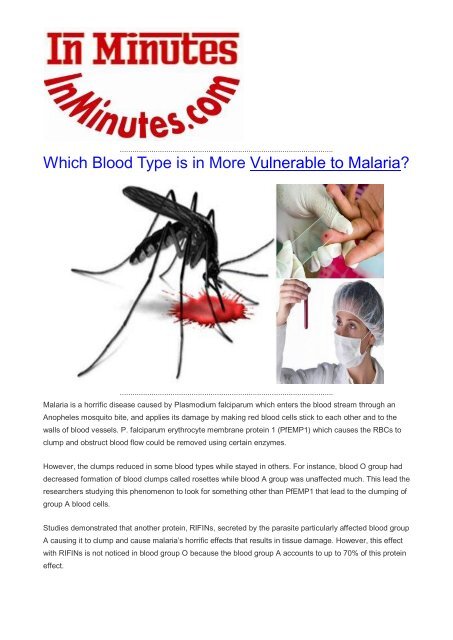Which Blood Type is in More Vulnerable to Malaria
Malaria is a horrific disease caused by Plasmodium falciparum which enters the blood stream through an Anopheles mosquito bite, and applies its damage by making red blood cells stick to each other and to the walls of blood vessels.
Malaria is a horrific disease caused by Plasmodium falciparum which enters the blood stream through an Anopheles mosquito bite, and applies its damage by making red blood cells stick to each other and to the walls of blood vessels.
You also want an ePaper? Increase the reach of your titles
YUMPU automatically turns print PDFs into web optimized ePapers that Google loves.
.....................................................................................................<br />
<strong>Which</strong> <strong>Blood</strong> <strong>Type</strong> <strong>is</strong> <strong>in</strong> <strong>More</strong> <strong>Vulnerable</strong> <strong>to</strong> <strong>Malaria</strong>?<br />
.....................................................................................................<br />
<strong>Malaria</strong> <strong>is</strong> a horrific d<strong>is</strong>ease caused by Plasmodium falciparum which enters the blood stream through an<br />
Anopheles mosqui<strong>to</strong> bite, and applies its damage by mak<strong>in</strong>g red blood cells stick <strong>to</strong> each other and <strong>to</strong> the<br />
walls of blood vessels. P. falciparum erythrocyte membrane prote<strong>in</strong> 1 (PfEMP1) which causes the RBCs <strong>to</strong><br />
clump and obstruct blood flow could be removed us<strong>in</strong>g certa<strong>in</strong> enzymes.<br />
However, the clumps reduced <strong>in</strong> some blood types while stayed <strong>in</strong> others. For <strong>in</strong>stance, blood O group had<br />
decreased formation of blood clumps called rosettes while blood A group was unaffected much. Th<strong>is</strong> lead the<br />
researchers study<strong>in</strong>g th<strong>is</strong> phenomenon <strong>to</strong> look for someth<strong>in</strong>g other than PfEMP1 that lead <strong>to</strong> the clump<strong>in</strong>g of<br />
group A blood cells.<br />
Studies demonstrated that another prote<strong>in</strong>, RIFINs, secreted by the parasite particularly affected blood group<br />
A caus<strong>in</strong>g it <strong>to</strong> clump and cause malaria’s horrific effects that results <strong>in</strong> t<strong>is</strong>sue damage. However, th<strong>is</strong> effect<br />
with RIFINs <strong>is</strong> not noticed <strong>in</strong> blood group O because the blood group A accounts <strong>to</strong> up <strong>to</strong> 70% of th<strong>is</strong> prote<strong>in</strong><br />
effect.
The studies also showed new knowledge about RIFINs and state that about 150 rif genes carry the genetic<br />
<strong>in</strong>formation for them <strong>to</strong> develop around blood group A.<br />
Due <strong>to</strong> the difference <strong>in</strong> the severity of malaria <strong>in</strong> different blood types, areas where malaria spread show<br />
<strong>in</strong>creased number of people with blood group O. Whatever your blood group <strong>is</strong>, you should take all the<br />
proper measurements <strong>to</strong> avoid catch<strong>in</strong>g a d<strong>is</strong>ease as deadly as malaria. Prevention measures <strong>in</strong>clude us<strong>in</strong>g<br />
Insecticide-treated mosqui<strong>to</strong> nets (ITNs).
<strong>Vulnerable</strong> <strong>to</strong> <strong>Malaria</strong>, Health, health care

















